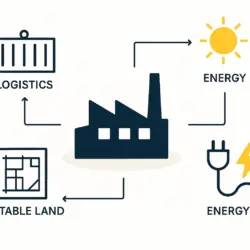Angola has launched the 100 MW M’Gahe solar project in Malanje province, a critical step toward its goal of generating 800 MW of solar power by 2025. Developed in partnership with TotalEnergies, the new facility will connect to the national grid, serving the country’s central and northern regions.
A Milestone in Angola’s Energy Strategy
The M’Gahe solar project marks a significant milestone in Angola’s broader strategy to diversify its energy sources and reduce its reliance on fossil fuels. This new facility brings the country closer to its target of producing 800 MW of solar power by 2025. To learn more about the broader impact of Angola’s solar initiatives, check out this detailed report.
As a key part of Angola’s energy transformation, the M’Gahe project’s 100 MW contribution to the national grid will help stabilize the power supply across the central and northern regions. This is especially important for the host province of Malanje, as it provides a more reliable and sustainable source of energy for residents and industries.
Partnership with TotalEnergies
The M’Gahe solar project is a collaboration between Angola and TotalEnergies, a global leader in renewable energy. With its significant expertise and resources, TotalEnergies has been instrumental in developing the country’s solar infrastructure.
As part of a broader strategy to support African countries in their energy transitions, TotalEnergies has already completed three other solar projects in Angola. These include the 35 MW Quilemba project, the 100 MW Quileva solar plant, and the 64 MW Lucapa solar plant in Lunda Norte province.
Alongside the M’Gahe project, Angola has several other solar initiatives planned, including two additional 100 MW projects in the Benguela and Namibe provinces. Once complete, these facilities will further boost the nation’s solar capacity and help it achieve a more complete solar Angola strategy by 2025. More details on these future projects can be found here.
Economic and Environmental Impact
The M’Gahe solar project offers both a significant economic opportunity and a major step toward a more sustainable energy future for Angola. Its construction and operation will create jobs and stimulate economic growth in Malanje province while reducing the nation’s carbon footprint by replacing fossil fuel-based energy with clean, renewable power.
This commitment to solar is part of the government’s broader strategy to diversify Angola’s energy mix and reduce its dependence on oil. By investing in solar power, Angola is positioning itself as a leader in renewable energy in Africa and could even export excess power to neighboring countries in the future.
The Road Ahead for Renewable Energy in Angola
As Angola continues to expand its solar infrastructure, the M’Gahe project underscores the country’s commitment to a sustainable energy future. With support from international partners like TotalEnergies, Angola is on track to meet its goal of generating 800 MW of solar power by 2025.
The success of the M’Gahe project and other solar initiatives will be crucial for meeting Angola’s energy needs while reducing its environmental impact. Continued investment in renewable energy will not only yield significant economic benefits but also contribute to global efforts to combat climate change. For more on the potential challenges and solutions in renewable energy deployment, see this comprehensive analysis.



